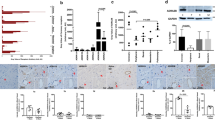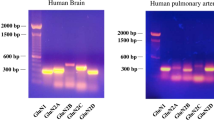Abstract
Stimulation of P2X receptors by ATP in vascular smooth muscle cells (VSMCs) is proposed to mediate vascular tone. However, understanding of P2X receptor-mediated actions in human blood vessels is limited, and therefore, the current work investigates the role of P2X receptors in freshly isolated small human gastro-omental arteries (HGOAs). Expression of P2X1 and P2X4 receptor subunit messenger RNA (mRNA) and protein was identified in individual HGOA VSMCs using RT-PCR and immunofluorescent analysis and using Western blot in multi-cellular preparations. ATP of 10 μmol/l and αβ-meATP of 10 μmol/l, a selective P2X receptor agonist, evoked robust increases in [Ca2+]i in fluo-3-loaded HGOA VSMCs. Pre-incubation with 1 μmol/l NF279, a selective P2X receptor antagonist, reduced the amplitude of αβ-meATP-induced increase in [Ca2+]i by about 70 %. ATP of 10 μmol/l and αβ-meATP of 10 μmol/l produced similar contractile responses in segments of HGOA, and these contractions were greatly reduced by 2 μmol/l NF449, a selective P2X receptor inhibitor. These data suggest that VSMCs from HGOA express P2X1 and P2X4 receptor subunits with homomeric P2X1 receptors likely serving as the predominant target for extracellular ATP.




Similar content being viewed by others
References
Bo X, Sexton A, Xiang Z, Nori SL, Burnstock G (1998) Pharmacological and histochemical evidence for P2X receptors in human umbilical vessels. Eur J Pharmacol 353(1):59–65
Braun K, Rettinger J, Ganso M, Kassack M, Hildebrandt C, Ullmann H, Nickel P, Schmalzing G, Lambrecht G (2001) NF449: a subnanomolar potency antagonist at recombinant rat P2X1 receptors. Naunyn Schmiedebergs Arch Pharmacol 364(3):285–290
Burnstock G (1972) Purinergic nerves. Pharmacol Rev 24(3):509–581
Burnstock G (1990) Local mechanisms of blood flow control by perivascular nerves and endothelium. J Hypertens Suppl 8(7):S95–S106
Burnstock G (1990) Noradrenaline and ATP as cotransmitters in sympathetic nerves. Neurochem Int 17(2):357–368
Cario-Toumaniantz C, Loirand G, Ladoux A, Pacaud P (1998) P2X7 receptor activation-induced contraction and lysis in human saphenous vein smooth muscle. Circ Res 83(2):196–203
Clifford EE, Parker K, Humphreys BD, Kertesy SB, Dubyak GR (1998) The P2X1 receptor, an adenosine triphosphate-gated cation channel, is expressed in human platelets but not in human blood leukocytes. Blood 91(9):3172–3181
Evans RJ, Surprenant A (1992) Vasoconstriction of guinea-pig submucosal arterioles following sympathetic nerve stimulation is mediated by the release of ATP. Br J Pharmacol 106(2):242–249
Harhun M, Gordienko D, Kryshtal D, Pucovsky V, Bolton T (2006) Role of intracellular stores in the regulation of rhythmical [Ca(2+)]i changes in interstitial cells of Cajal from rabbit portal vein. Cell Calcium 40(3):287–298
Harhun MI, Huggins CL, Ratnasingham K, Raje D, Moss RF, Szewczyk K, Vasilikostas G, Greenwood IA, Khong TK, Wan A, Reddy M (2012) Resident phenotypically modulated vascular smooth muscle cells in healthy human arteries. J Cell Mol Med 16(11):2802–2812
Harhun MI, Povstyan OV, Gordienko DV (2010) Purinoreceptor-mediated current in myocytes from renal resistance arteries. Br J Pharmacol 160(4):987–997
Harhun MI, Szewczyk K, Laux H, Prestwich SA, Gordienko DV, Moss RF, Bolton TB (2009) Interstitial cells from rat middle cerebral artery belong to smooth muscle cell type. J Cell Mol Med 13(11–12):4532–4539
Huggins CL, Povstyan OV, Harhun MI (2013) Characterization of transcriptional and posttranscriptional properties of native and cultured phenotypically modulated vascular smooth muscle cells. Cell Tissue Res 352(2):265–275
Hulsmann M, Nickel P, Kassack M, Schmalzing G, Lambrecht G, Markwardt F (2003) NF449, a novel picomolar potency antagonist at human P2X1 receptors. Eur J Pharmacol 470(1–2):1–7
Jiang L, Bardini M, Keogh A, dos Remedios CG, Burnstock G (2005) P2X1 receptors are closely associated with connexin 43 in human ventricular myocardium. Int J Cardiol 98(2):291–297
Lecut C, Frederix K, Johnson DM, Deroanne C, Thiry M, Faccinetto C, Maree R, Evans RJ, Volders PG, Bours V, Oury C (2009) P2X1 ion channels promote neutrophil chemotaxis through Rho kinase activation. J Immunol 183(4):2801–2809
Li L, Wu Y, Deng M, Wu G, Ren L (2012) P2X1 receptor-mediated pressor responses in the anesthetized mouse. Acta Pharm Sin B 2(5):459–463
Malmsjo M, Hou MF, Pendergast WF, Erlinge DF, Edvinsson L (2003) Potent P2Y6 receptor mediated contractions in human cerebral arteries. BMC Pharmacol 3:4
Mulvany MJ, Aalkjaer C (1990) Structure and function of small arteries. Physiol Rev 70(4):921–961
Nichols CM, Povstyan OV, Khan O, Vasilikostas G, Khong TK, Wan A, Reddy M, Harhun MI (2013) Molecular identification of P2X receptors in human arteries. Proc 37th IUPS, PCA407
Nicke A, Kerschensteiner D, Soto F (2005) Biochemical and functional evidence for heteromeric assembly of P2X1 and P2X4 subunits. J Neurochem 92(4):925–933
Nicke A, Rettinger J, Schmalzing G (2003) Monomeric and dimeric byproducts are the principal functional elements of higher order P2X1 concatamers. Mol Pharmacol 63(1):243–252
North RA (2002) Molecular physiology of P2X receptors. Physiol Rev 82(4):1013–1067
Osmond DA, Inscho EW (2010) P2X(1) receptor blockade inhibits whole kidney autoregulation of renal blood flow in vivo. Am J Physiol Renal Physiol 298(6):F1360–F1368
Pakdeechote P, Rummery NM, Ralevic V, Dunn WR (2007) Raised tone reveals purinergic-mediated responses to sympathetic nerve stimulation in the rat perfused mesenteric vascular bed. Eur J Pharmacol 563(1–3):180–186
Povstyan OV, Harhun MI, Gordienko DV (2011) Ca(2+) entry following P2X receptor activation induces IP(3) receptor-mediated Ca(2+) release in myocytes from small renal arteries. Br J Pharmacol 162(7):1618–1638
Povstyan OV, Nichols CM, Harhun MI (2013) Identification of functional P2X receptors in rat middle cerebral arteries. Proc 37th IUPS PCA395-
Ralevic V (2012) P2X receptors in the cardiovascular system. WIREs Membr Transp Signal 1(5):663–674
Rettinger J, Schmalzing G, Damer S, Muller G, Nickel P, Lambrecht G (2000) The suramin analogue NF279 is a novel and potent antagonist selective for the P2X(1) receptor. Neuropharmacology 39(11):2044–2053
Rummery NM, Brock JA, Pakdeechote P, Ralevic V, Dunn WR (2007) ATP is the predominant sympathetic neurotransmitter in rat mesenteric arteries at high pressure. J Physiol 582(Pt 2):745–754
Somlyo AP (1985) Excitation-contraction coupling and the ultrastructure of smooth muscle. Circ Res 57(4):497–507
Soto F, Garcia-Guzman M, Gomez-Hernandez JM, Hollmann M, Karschin C, Stuhmer W (1996) P2X4: an ATP-activated ionotropic receptor cloned from rat brain. Proc Natl Acad Sci U S A 93(8):3684–3688
Torres GE, Egan TM, Voigt MM (1999) Hetero-oligomeric assembly of P2X receptor subunits. Specificities exist with regard to possible partners. J Biol Chem 274(10):6653–6659
Valdecantos P, Briones R, Moya P, Germain A, Huidobro-Toro JP (2003) Pharmacological identification of P2X1, P2X4 and P2X7 nucleotide receptors in the smooth muscles of human umbilical cord and chorionic blood vessels. Placenta 24(1):17–26
Wallis SJ, Firth J, Dunn WR (1996) Pressure-induced myogenic responses in human isolated cerebral resistance arteries. Stroke 27(12):2287–2290
Zsembery A, Boyce AT, Liang L, Peti-Peterdi J, Bell PD, Schwiebert EM (2003) Sustained calcium entry through P2X nucleotide receptor channels in human airway epithelial cells. J Biol Chem 278(15):13398–13408
Acknowledgments
This work was supported by the British Heart Foundation Intermediate Basic Science Research Fellowship to M.I.H. (FS/06/077) and BHF grant (PG/08/062/) to D.V.G. and M.I.H.
Author information
Authors and Affiliations
Corresponding author
Electronic supplementary material
Below is the link to the electronic supplementary material.
Supplementary Fig. 1
(DOC 458 kb)
Rights and permissions
About this article
Cite this article
Nichols, C.M., Povstyan, O.V., Albert, A.P. et al. Vascular smooth muscle cells from small human omental arteries express P2X1 and P2X4 receptor subunits. Purinergic Signalling 10, 565–572 (2014). https://doi.org/10.1007/s11302-014-9415-6
Received:
Accepted:
Published:
Issue Date:
DOI: https://doi.org/10.1007/s11302-014-9415-6




